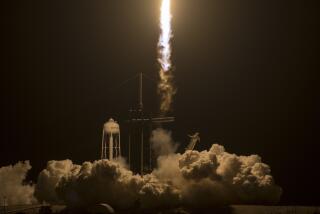Human error doomed Mars craft
- Share via
A command sent to the wrong computer address caused a cascade of events that led to the loss of the Mars Global Surveyor spacecraft in November, NASA investigators reported Friday.
The error by ground controllers in Denver caused the spacecraft to mistakenly think its solar panels were stuck. By trying to free them, one of its onboard batteries overheated, eventually causing a loss of power.
The spacecraft, which had orbited Mars for 10 years, was given up for lost Jan. 28.
The spacecraft was managed by the Jet Propulsion Laboratory in La Canada Flintridge and Lockheed Martin Space Systems in Denver.
Although the command error apparently originated in Denver, a spokesman at JPL said the team shared the credit for the spacecraft’s successes and the blame for its loss.
Fuk Li, manager of the Mars exploration program at JPL, said an “end-to-end” review of all missions would be undertaken to make sure the mistakes made with the spacecraft were not repeated.
Mars Global Surveyor was launched in 1996 on what was expected to be a two-year mapping and science mission. Its mission was extended four times by NASA.
The spacecraft discovered that Mars’ surface was made up of large amounts of sedimentary rocks, suggesting a more complicated geological history than had been previously thought. It also found that carbon dioxide ice was disappearing from the planet’s south pole, raising the possibility that a new round of global warming was underway on the planet.
Its most exciting find was announced in December, just weeks after it was lost. Scientists presented evidence that water still flowed on the Martian surface from small springs.
According to a preliminary report from the Mars Global Surveyor operations review board, the problems with the spacecraft began in June, when a command that oriented the spacecraft’s main communications antenna was sent to the wrong address. The mistake caused a problem with the positioning of the solar power panels.
The problems came to a head Nov. 2, when the spacecraft detected the positioning error and tried to go into a safe, or contingency, mode.
That exposed one of the batteries to direct sunlight, causing it to overheat.
Software on the spacecraft interpreted the overheating as an overcharged battery and shut down the charging system. As a result, the batteries drained within 12 hours, resulting in a loss of communications with Earth.
The review panel found that the management team followed procedures in dealing with the problem but that the procedures “were inadequate to catch the errors that occurred.”
The review also said the spacecraft’s onboard fault protection system failed to respond to the errors. Instead of protecting the spacecraft, the programmed response made it worse.
The panel, led by Dolly Perkins, deputy director of NASA’s Goddard Space Flight Center in Greenbelt, Md., also noted that over the years budgets and staff had been cut “in an effort to operate the mission as economically as possible.”






